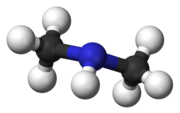This is an old revision of this page, as edited by Beetstra (talk | contribs) at 15:10, 8 August 2011 (Script assisted update of identifiers for the Chem/Drugbox validation project (updated: 'ChEBI').). The present address (URL) is a permanent link to this revision, which may differ significantly from the current revision.
Revision as of 15:10, 8 August 2011 by Beetstra (talk | contribs) (Script assisted update of identifiers for the Chem/Drugbox validation project (updated: 'ChEBI').)(diff) ← Previous revision | Latest revision (diff) | Newer revision → (diff) | |
 | |
| Names | |
|---|---|
| IUPAC name Dimethylamine | |
| Identifiers | |
| CAS Number | |
| 3D model (JSmol) | |
| ChEBI | |
| ChEMBL | |
| ChemSpider | |
| ECHA InfoCard | 100.004.272 |
| KEGG | |
| PubChem CID | |
| UNII | |
| CompTox Dashboard (EPA) | |
InChI
| |
SMILES
| |
| Properties | |
| Chemical formula | C2H7N |
| Molar mass | 45.08 g/mol |
| Appearance | Colorless gas with pungent odor |
| Density | 0.67 g/cm (21 °C, 1 atm) |
| Melting point | −92.2 °C (−134.0 °F; 181.0 K) |
| Boiling point | 7 °C (45 °F; 280 K) |
| Solubility in water | 354 g/100 mL |
| Acidity (pKa) | 10.64 |
| Thermochemistry | |
| Std enthalpy of formation (ΔfH298) |
-18.422 kJ/mol |
| Hazards | |
| NFPA 704 (fire diamond) |
 |
| Flash point | Flammable gas |
| Explosive limits | 2.8–14.4% |
| Supplementary data page | |
| ] | |
| Related compounds | |
| Except where otherwise noted, data are given for materials in their standard state (at 25 °C , 100 kPa).
| |
Dimethylamine is an organic compound with the formula (CH3)2NH. This secondary amine is a colorless, flammable liquified gas with an ammonia-like odor. Dimethylamine is generally encountered as a solution in water at concentrations up to around 40%. In 2005, an estimated 270,000 tons were produced.
Structure and properties
The molecule consists of a nitrogen atom with two methyl substituents and one proton. Dimethylamine is a base and the pKa of the ammonium salt CH3-NH2-CH3 is 10.73, a value above methylamine (10.64) and trimethylamine (9.79). Dimethylamine reacts with acids to form salts, such as dimethylamine hydrochloride, an odorless white solid with a melting point of 171.5 °C. Dimethylamine is produced by catalytic reaction of methanol and ammonia at elevated temperatures and high pressure:
- 2 CH3OH + NH3 → (CH3)2NH + 2 H2O
Uses
Dimethylamine is a precursor to several industrially significant compounds. It reacts with carbon disulfide to give dimethyldithiocarbamate, a precursor to a family of chemicals widely used in the vulcanization of rubber. The solvents dimethylformamide and dimethylacetamide are derived from dimethylamine. It is raw material for the production of many agrichemicals and pharmaceuticals, such as dimefox and diphenhydramine, respectively. The chemical weapon tabun is derived from dimethylamine. The surfactant lauryl dimethylamine oxide is found in soaps and cleaning compounds. Unsymmetrical dimethylhydrazine, a rocket fuel, is prepared from dimethylamine.
Biochemistry
The German cockroach utilizes dimethylamine as a pheromone for communication.
DMA undergoes nitrosation under weak acid conditions to give dimethylnitrosamine. This animal carcinogen has been detected and quantified in human urine samples and it may also arise from nitrosation of DMA by nitrogen oxides present in acid rain in highly industrialized countries.
See also
- Methylamine
- Trimethylamine
- Geranamine (1,3-dimethypentylamine)
References
- Hall, H.K., J. Am. Chem. Soc., 1957, 79, 5441.
- ^ A. B. van Gysel, W. Musin "Methylamines" in Ullmann's Encyclopedia of Industrial Chemistry, 2005 Wiley-VCH Verlag, Weinheim. doi:10.1002/14356007.a16 535
- Corbin D.R.; Schwarz S.; Sonnichsen G.C. (1997). "Methylamines synthesis: A review". Catalysis Today. 37 (2): 71–102. doi:10.1016/S0920-5861(97)00003-5.
{{cite journal}}: CS1 maint: multiple names: authors list (link) - Ashford's Dictionary of Industrial Chemicals, 3rd edition, 2011, pages 3284-3286
- Zhang AQ, Mitchell SC, Smith RL (1998). "Dimethylamine formation in the rat from various related amine precursors". Food Chem. Toxicol. 36 (11): 923–7. doi:10.1016/S0278-6915(98)00074-X. PMID 9771553.
{{cite journal}}: Unknown parameter|month=ignored (help)CS1 maint: multiple names: authors list (link)
External links
- International Chemical Safety Card 0260 (gas)
- International Chemical Safety Card 1485 (aqueous solution)
- NIOSH Pocket Guide to Chemical Hazards. "#0219". National Institute for Occupational Safety and Health (NIOSH).
- Properties from Air Liquide
- MSDS at airliquide.com
- MSDS at physchem.ox.ac.uk
- Examine.com